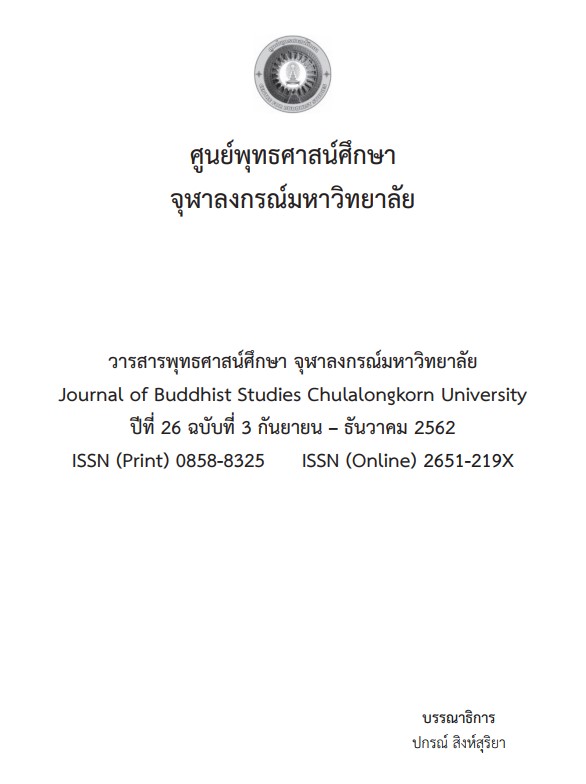ทัศนะของพระพุทธเจ้าต่อการเล่าเรียนพระธรรมวินัยจากอุปมาจับงูพิษในอลคัททูปมสูตร
คำสำคัญ:
อลคัททูปมสูตร, การเล่าเรียนธรรม, อุปมาบทคัดย่อ
บทความนี้มีวัตถุประสงค์เพื่อศึกษาวิเคราะห์เจตนาของพระพุทธเจ้า ที่ทรงเปรียบการเรียนพระธรรมวินัยกับการจับงูพิษในอลคัททูปมสูตร มัชฌิมนิกาย มูลปัณณาสก์ ตามแนวคิดของทฤษฎีภาษาศาสตร์ปริชาน ด้วยการศึกษา ภาพพจน์เกี่ยวกับงูที่ปรากฏและคําสอนของพระพุทธเจ้าเกี่ยวกับการศึกษา พระธรรมวินัยในพระไตรปิฎก จากการศึกษาพบว่ามีการใช้ภาพพจน์เกี่ยวกับงู ในพระไตรปิฎก 2 ลักษณะ ได้แก่ ในความหมายที่เกี่ยวข้องกับสิ่งอันตราย ที่บุคคลพึงละเว้น และในความหมายที่เกี่ยวข้องกับการละสรีระเก่าและการ เกิดใหม่ การเปรียบเทียบกับการจับงูพิษในอลคัททูปมสูตรแม้จะใกล้เคียงกับ ภาพพจน์เกี่ยวกับงูในความหมายแรกแต่การที่ทรงสนับสนุนการเรียนพระธรรมวินัยในขณะเดียวกันทําให้เห็นว่าอุปมาจับงูพิษมีนัยเป็นคําเตือนของพระพุทธเจ้า ต่อการเรียนพระธรรมวินัยซึ่งเป็นการงานเบื้องต้นของพระภิกษุ เพราะน่าจะทรง เห็นว่าการสืบทอดศาสนธรรมตั้งอยู่ในบรรยากาศให้ผู้เรียนเกิดกิเลสได้ง่าย พระภิกษุผู้ซึ่งเป็นปุถุชนจึงอาจผิดพลาดร้ายแรงได้เสมอ หากหลงระเริงในความ สําเร็จและลาภสักการะที่เกิดขึ้น ดังนั้น พระภิกษุผู้อยู่บนเส้นทางของการศึกษา ปริยัติจึงต้องสํารวมระวังด้วยความไม่ประมาทและมุ่งมั่นต่อความพ้นทุกข์อันเป็น เป้าหมายของพระพุทธศาสนา
Downloads
เอกสารอ้างอิง
บุญชอบ เริงทรัพย์. (2520). อุปมาอุปไมยในพระไตรปิฎก. (วิทยานิพนธ์ปริญญามหาบัณฑิต จุฬาลงกรณ์มหาวิทยาลัย)
พระไตรปิฎกฉบับหลวง สืบค้นจากโปรแกรม E-Tipitaka 3.0.9
พระพุทธโฆสาจารย์. (2554). คัมภีร์วิสุทธิมรรค. (สมเด็จพระพุฒาจารย์ (อาจ อาสโภ), ผู้แปล). (พิมพ์ครั้งที่ 10). กรุงเทพมหานคร: ธนาเพรส.
พระมหาอภิชาติ กรณฺยวสี (เบ้าคํา). (2550). การศึกษาเชิงวิเคราะห์อลคัททูปมสูตร.(วิทยานิพนธ์ปริญญามหาบัณฑิต, มหาวิทยาลัยมหาจุฬาลงกรณราชวิทยาลัย)
พีรายุตม์ สังฆะมณี. (2557). การประยุกต์ใช้หลักธรรมในอลคัททูปมสูตรในสังคมปัจจุบัน. วารสารมนุษยศาสตร์และสังคมศาสตร์, มหาวิทยาลัยราชภัฏอุบลราชธานี. 5(1), 153-156.
อรรถกถาบาลี ฉบับสยามรัฐ สืบค้นจาก https://www.thepathofpurity.com/
อสรพิษร้ายแห่งเอเชีย [CD-Rom]. (2542). กรุงเทพมหานคร: จีเอ็มคอร์ปอเรชั่น.
Halpern, Paul. (1995). The Cyclical Serpent, Prospects for an Ever-Repeating Universe. Springer.
Israel, Michael, et al. (2004). On Simile. In Michel Achard & Suzanne Kemmer (Eds.), Language, Culture, and Mind (EBSCO eBook).
Peters, James A and Wallach, Van. Snake (Reptile). In Encyclopedia Britannica [Online]. Retrieved May 19, 2019. Retrieved from https,//www.britannica.com/animal/snake
Ritchie, L. David. (2006). Context and Connection in Metaphor. New York: Palgrave Macmillan.
Ritchie, L. David.. (2013). Metaphor. Key Topics in Semantics and Pragmatics. Cambridge: Cambridge University Press.
Thanissaro Bhikkhu. (2004). (Translator’s Introduction) Alagaddupama
Sutta, The Water-Snake Simile [Online]. Retrieved from https,//www.accesstoinsight.org/tipitaka/mn/mn.022.than.html
Vogel, Joseph. (1926). Indian Serpent-Lore, or the Nagas in Hindu Legend and Art. London : Arthur Probsthain.
ดาวน์โหลด
เผยแพร่แล้ว
รูปแบบการอ้างอิง
ฉบับ
ประเภทบทความ
สัญญาอนุญาต
บทความที่ได้รับการตีพิมพ์เป็นลิขสิทธิ์ของศูนย์พุทธศาสน์ จุฬาลงกรณ์มหาวิทยาลัย
ข้อความที่ปรากฏในบทความแต่ละเรื่องในวารสารวิชาการเล่มนี้เป็นความคิดเห็นส่วนตัวของผู้เขียนแต่ละท่านไม่เกี่ยวข้องกับศูนย์พุทธศาสน์ จุฬาลงกรณ์มหาวิทยาลัย และคณาจารย์ท่านอื่นๆในมหาวิทยาลัยฯ แต่อย่างใด ความรับผิดชอบองค์ประกอบทั้งหมดของบทความแต่ละเรื่องเป็นของผู้เขียนแต่ละท่าน หากมีความผิดพลาดใดๆ ผู้เขียนแต่ละท่านจะรับผิดชอบบทความของตนเองแต่ผู้เดียว






